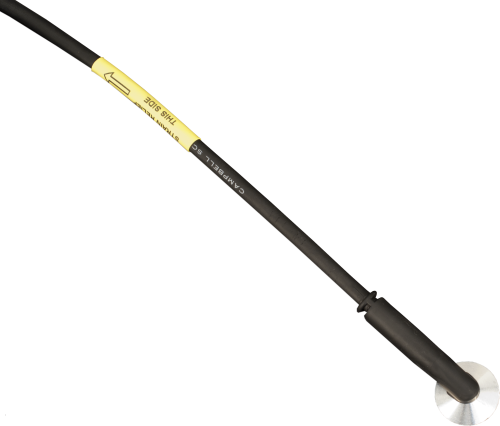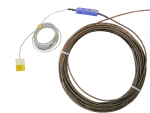
| Services Available | |
|---|---|
| Repair | No |
| Calibration | No |
| Free Support | Yes |
Überblick
Der 110PV ist ein Thermistor der an eine flache Oberfläche angeklebt werden kann. Typischerweise wird er zur Überwachung der Temperatur von Solarmodulen verwendet, kann aber auch für andere Anwendungen eingesetzt werden. Der Thermistor kann mit unseren Datenloggern problemlos abgefragt werden.
Lesen Sie mehrFunktionen und Vorteile
- Misst Temperaturen im Bereich von -40°C bis zu +135°C
- Einfache Installation – Klebestreifen auf der glatten Oberfläche des 110PV kleben den Sensor auf die Rückseite einer Solarzelle oder auf ein anderes Gerät
- Aluminiumscheibe schützt den Thermistor und fördert den Wärmefluss von der Oberfläche
- Macht akkurate Messungen auch in Umgebungen mit starken elektromagnetischen Inteferenzen
- Kompatibel mit dem CWS900 zur Verwendung in einem kabellosen Netzwerk
Bilder




Technische Beschreibung
The 110PV consists of a thermistor encased in an aluminium disk. The disk protects the thermistor and promotes heat transfer from surfaces. An adhesive tab on the probe’s aluminium disk fastens the 110PV to the measurement surface. If the temperature may exceed 70°C, Kapton tape is also required to secure the probe; Kapton tape is offered as a Common Accessory (see Ordering Info). Note: Campbell Scientific does not recommend using epoxy to secure the 110PV to a PV module.
The 110PV can provide the photovoltaic (PV) module temperature for solar energy applications. This measurement is useful because the output of a PV module is affected by its temperature. As the temperature of the PV module increases, its output decreases.
Kompatibel mit
Please note: The following shows notable compatibility information. It is not a comprehensive list of all compatible products.
Datenlogger
| Product | Compatible | Note |
|---|---|---|
| CR1000 (retired) | ||
| CR1000X (retired) | ||
| CR200X (retired) | ||
| CR216X (retired) | ||
| CR300 (retired) | ||
| CR3000 | ||
| CR310 | ||
| CR5000 (retired) | ||
| CR6 | ||
| CR800 (retired) | ||
| CR850 (retired) | ||
| CR9000X (retired) |
Additional Compatibility Information
Mounting
For temperatures up to 70°C, an adhesive tab on the probe’s aluminum disk fastens the 110PV to the measurement surface. If the temperature may exceed 70°C, Kapton tape is recommended to secure the probe to the measurement surface. Kapton tape is available from Campbell Scientific (see Ordering Information).
The 110PV can be submerged to 50 ft, but the probe’s adhesive tab is not intended for submersion. Therefore the 110PV must be mounted to the measurement surface via a user-supplied method that is compatible with submersion.
Data Logger Considerations
Programming
The CR200(X)-series dataloggers use the ExDelSe instruction to measure the 110PV. The CR800, CR850, CR1000, CR3000, CR5000, and CR9000(X) can use either the BrHalf4W instruction or BrHalf instruction to measure the 110PV. For these data loggers, the BrHalf4W instruction is typically preferred because it reduces cable errors. The BrHalf instruction requires fewer input channels.
In Edlog, Instruction 5 is typically used to measure the 110PV. The ratio metric output is then converted to resistance and finally to temperature.
Spezifikationen
| Sensor | Thermistor with specially designed protective aluminum disk |
| Measurement Description | Back-of-module temperature |
| Operating Temperature Range | -40° to +135°C |
| Temperature Survival Range | -50° to +140°C |
| Temperature Uncertainty |
|
| Sensitivity | +1°C |
| Steinhart-Hart Linearization Equation Error | 0.0024°C (at -40°C) maximum |
| Disk Material | Anodized aluminum |
| Cable Jacket Material | Santoprene |
| Cable/Probe Connection Material | Santoprene |
| Maximum Lead Length | 304.8 m (1000 ft) |
| Disk Diameter | 2.54 cm (1.0 in.) |
| Probe Length | 6.35 cm (2.5 in.) |
| Overmolded Joint Dimensions | 5.72 x 1.12 x 1.47 cm (2.25 x 0.44 x 0.58 in.) |
| Weight | 90.7 g with 3.2-m cable (0.2 lb with 10.5-ft cable) |
Dokumente
Broschüren Produkte
Handbücher
FAQs für
Number of FAQs related to 110PV: 16
Alle anzeigenWenige anzeigen
-
NIST traceability provides an assurance of accuracy. This is especially desirable in accordance with IEC 61724, which is a solar energy generation monitoring specification that requires calibrated sensors.
-
There is no outside visual damage bending the cable over on itself 180°. But for long-term durability purposes, any bends should not be smaller than a 0.5 in. radius.
-
Yes. After adhering the sensor to a dry surface, the sensor can be submerged up to 50 ft in depth.
-
In either a 3-wire or 4-wire half-bridge configuration. For details, refer to the 110PV-L Instruction Manual.
-
That depends on which datalogger is being used and how the 110PV-L has been wired. For more details, see the 110PV-L Instruction Manual.
-
Yes, which means it can be wired directly to a datalogger.
-
The sensor behaves exceptionally well (temperature uncertainty <0.2°C) between -40 and +80 degrees Celsius.
-
Some of the more common readings that indicate a sensor is malfunctioning include NANs (not a number) or unrealistic values such as a panel temperature reading of 500 degrees Celsius. If NANs occur, it is possible that there may be either programming or wiring errors. Double-check the setup, and contact Campbell Scientific for assistance if the issue continues. Depending on the sensor behavior, the sensor may need to be returned to Campbell Scientific for repair.
-
Currently, Short Cut only offers a half-bridge measurement option, and the resistance is not calculated. Each cable resistance is measured at the factory and labeled with its unique reading. That resistance value is called for when adding a 110PV-L sensor to the Short Cut program.
-
When these sensors are purchased, the following calibration services are offered: TEMPCAL and TEMPCAL2.
- TEMPCAL provides a single-point calibration and a calibration certificate. The single-point calibration determines the offset at 25°C with an uncertainty of ±0.05°C.
- TEMPCAL2 provides a two-point calibration and a calibration certificate. The two-point calibration determines offsets at 30°C and 65°C with an uncertainty of ±0.05°C.
For both of these services, calibration can be made at different values if it is requested by the purchaser at the time of purchase. In addition, both of these calibration services can be requested after sensor purchase using a return material authorization (RMA) number. To request an RMA number, refer to the Repair and Calibration page.


